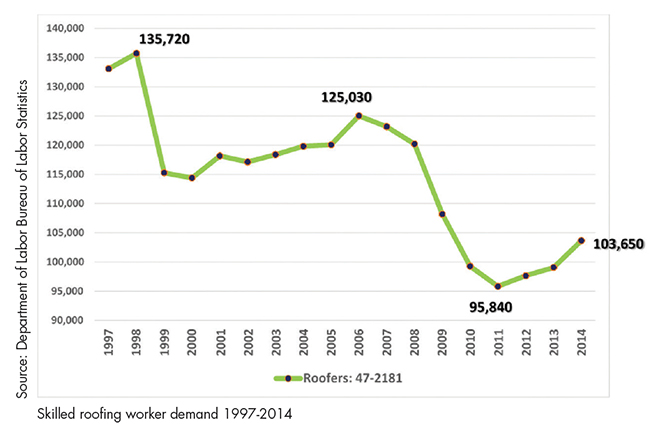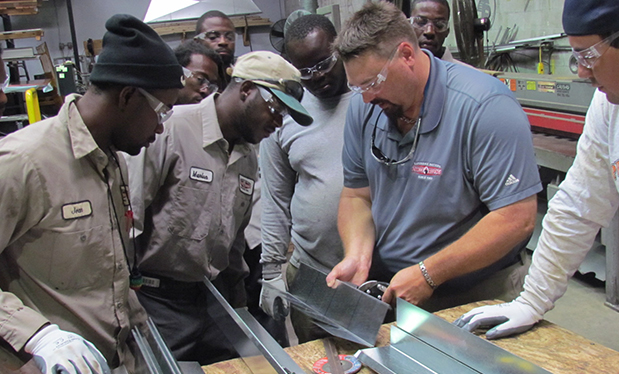It's no secret the roofing industry has been facing difficulty recruiting new workers. There is a long history of issues associated with recruiting workers into the roofing industry, and developing solutions requires a deep understanding of roofing work and the industry's workforce and its relationship to the U.S. marketplace.
One of several initiatives NRCA is implementing to help address the problem is a new online Career Center, which is scheduled to launch during the 2016 International Roofing Expo® (IRE).
A history of shortages
During the early 1980s, a shortage of skilled roofing workers arose as the U.S. economy rebounded from the recession of the 1970s.
The economic boom continued through the 1990s, and as new low- and steep-slope roof system installations demanded higher skill levels, the first wave of baby boomer retirees created a torrent of roofing industry workforce demand.
According to data from the Department of Labor's (DOL's) Bureau of Labor Statistics (BLS), that demand peaked in 1998 at 135,720 skilled roofing workers, excluding helpers/laborers. But this wave of workers was far short of meeting the industry workload at that time. Increasing immigrant worker populations—primarily Latinos—filled the void. The immigrant workforce in the roofing industry increased from less than 15 percent in 1994 to about 27 percent by 2000, according to BLS data.
Then came the tragic Sept. 11, 2001, attacks, and the U.S. economy came to a standstill. The demand for roofing work diminished significantly, and the workforce crisis disappeared.
Eventually, the U.S. economy healed, and roofing work gradually returned to previous levels, though somewhat inconsistently. The roofing workforce went back to work and met the demand.
Next came the worldwide economic recession that began around 2007 and reached its low point by 2011 (see the figure). This period created a permanent void of skilled craftsmen as mass numbers of roofing workers exited the industry to seek other careers.

|
Currently, the U.S. economy once again seems well on its way to recovery. BLS projects the construction industry will experience an 18 percent increase in demand for roofing workers by 2020, and so far this prediction seems accurate.
The current workforce
As a result of the improved economy, roofing contractors are again experiencing work backlogs, and currently no significant materials shortages are hindering project deliveries. Good news, indeed, for most industry stakeholders.
But history repeats itself. The recent increase in roofing work once again has created a workforce crisis.
During the past several years, few in the industry noticed—or simply chose to ignore—the fact that the labor pool composed of baby boomers is retiring at a rate of 10,000 workers per day, according to a 2015 Pew Research Center report. This pace is projected to continue for the next 19 years.
Meanwhile, the Latino roofing workforce has reached an all-time high of 58.1 percent, according to February 2015 BLS data. The Latino workforce is important to a productive roofing industry yet the industry has done little to provide Spanish-language training or try to understand and meet the needs of this labor source to create a new generation of roofing professionals.
An unforeseen challenge to the current roofing industry workforce is the tidal wave of advanced roofing technologies producing new roof systems requiring even higher skill levels to install such as roof-integrated solar photovoltaic systems; vegetative roof systems; self-adhering single-ply systems; and monolithic liquid-applied systems. NRCA produces guidelines and best practices for the design and installation of these systems, and these technical documents are being implemented every day by the design and building code sectors of the industry. But standardized curricula that support training of the workers who install these systems are almost nonexistent.
On top of these challenges, the roofing industry continues to face the general public's negative perception of roofing work as a career choice.
Nick Sabino, president of Deer Park Roofing, Cincinnati, is actively trying to recruit new workers.
"There was a time when all the advertising we did was to attract new customers," he says. "In this day and age, almost all the advertising we do is to attract new workers rather than finding work. We know we need to do more to attract new employees into the industry and not just exchange employees between companies. There simply are no new people out there who want to do roofing work."
According to Chad Collins, owner of Bone Dry Roofing, Atlanta, the roofing industry's current workforce crisis is serious.
"We now have to walk away from work opportunities simply because we can't get it done," says Collins. "We don't have enough workers with even the most basic roofing functions, and it's going to get a lot worse before it gets better."
During a recent NRCA workforce task force meeting, the consensus was the industry is losing between 10 and 20 percent of its work because contractors do not have an adequate or skilled workforce. In a $30 billion industry, this translates to between $3 billion and $6 billion of work being lost each year. Where is this work going?
"The work is going to the underground market where the nonskilled, uninsured contractors are getting away with delivering poor quality work that will end up hurting the industry—and its image—even more," Collins says.
NRCA's online Career Center
To help its members better address the workforce shortage, NRCA has developed a comprehensive roofing-industry specific online career center that will debut during the IRE in Orlando, Fla. The Career Center is anchored by a robust, dual-strategy job bank. It also is designed to function as a connecting hub for all industry stakeholders' workforce development and career resource needs.
There are four primary functioning sections comprising the new Career Center: Job Seekers, Employers, Education and Training Providers, and Workforce Developers.
Job seekers
The Job Seekers section will provide content in English and Spanish. Prospective candidates will be able to view videos that explain roofing careers in the field and other opportunities, such as contractor operations. Job seekers will be able to download career path brochures; have access to industry wage information; find related educational and training programs; and most important, have free access to a user-friendly job bank that connects prospective workers directly with employers.
Through the job bank, candidates can view available jobs posted by employers and apply online for those positions, posting resumes if desired. Candidates also will be able to choose a simplified approach that only requires them to set up an online account and create a basic personal profile that displays to employers their work experiences, area(s) in which they prefer to work and how much they would like to earn. Candidates also will be able to view company profiles in their geographic areas, providing employers an opportunity to display the benefits of working for them. This approach allows employers to view and pre-screen prospective candidates' qualifications before contacting them to recruit.
Employers
The employer section will provide companies with numerous resources to help them build competent workforces to meet their specific needs, starting with the job bank.
Employers can post available job positions and then directly receive online applications. Or, as previously described, they can preview several simplified worker profiles side-by-side to predetermine whether candidates might meet their companies' needs.
Examples of other employer resources include standardized industry job descriptions; tools to support recruiting efforts such as career brochures; downloadable recruiting videos; onboarding kits; retention best-practice guidance; and direct access to several worker training resources, including videos, instructor guides, online training programs and other training aids.
Education and training providers
This section will provide education and training providers direct student access to network with local employers for jobs, collaboration opportunities to help ensure curriculums meet specific local training needs and access to high-quality, industry-specific training materials. It also will provide recruiting opportunities for employers that choose to directly engage local vocational schools, community colleges or other local training centers.
Workforce developers
This section will provide a unique networking hub for industry stakeholders to connect directly with several local, state and/or regional organizations that provide job placement and career counseling services. It will provide general instructions for how to connect with these organizations, as well as provide the organizations with direct access to free roofing industry resources such as career brochures, videos and other career development resources.
A new kind of portal
The NRCA Career Center is a resource that will continually evolve, expand and provide the industry proactive solutions and a self-sustaining infrastructure for developing a highly skilled, competent workforce well into the future.
"I would like to see NRCA's Career Center become the vehicle for information exchange between employers and employees and to advance the conversation about the great career opportunities our industry provides with the public," Collins says. "Other sites are not roofing specific, but now we will have a one-stop resource for all levels of roofing industry work."
John Schehl, CAE, RRC, is executive director of Roof Integrated Solar Energy.™



